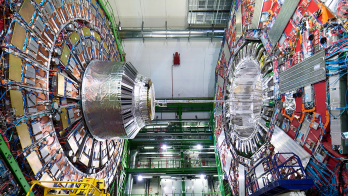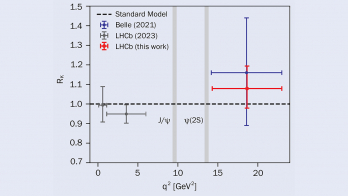A report from the LHCb experiment.

To explain the large matter–antimatter asymmetry in the universe, the laws of nature need to be asymmetric under a combination of charge-conjugation (C) and parity (P) transformations. The Standard Model (SM) provides a mechanism for CP violation, but it is insufficient to explain the observed baryon asymmetry in the universe. Thus, searching for new sources of CP violation is important.
The non-invariance of the fundamental forces under CP can lead to different rates between a particle and an antiparticle decay. The CP violation in the decay of a particle is quantified through the parameter ACP, equal to the relative difference between the decay rate of the process and the decay rate of the CP-conjugated process. Three years ago, the LHCb collaboration reported the first observation of CP violation in the decay of charmed hadrons by measuring the difference between the time-integrated ACP in D0 → K–K+ and D0 → π– π+ decays, ΔACP. This difference was found to lie at the upper end of the SM expectation, prompting renewed interest in the charm-physics community. There is now an ongoing effort to understand whether this signal is consistent with the SM or a sign of new physics.
At the 41st ICHEP conference in Bologna on 7 July, the LHCb collaboration announced a new measurement of the individual time-integrated CP asymmetry in the D0 → K–K+ decay using the data sample collected during LHC Run 2. The measured value, ACP(K–K+) = [6.8 ± 5.4 (stat) ± 1.6 (syst)] × 10–4, is almost three times more precise than the previous LHCb determination obtained with Run 1 data. This was thanks not only to a larger data sample but also the inclusion of additional control channels Ds+ → K– K+ π+ and Ds+ → Ks0 K+. Together with the previous control channels, D+ → K– π+ π+ and D+ → Ks0 π+, these decays allow the separation between tiny signals of CP asymmetries from the much larger bias due to the asymmetric meson production and instrumental effects.
The combination of the measured values with the previously obtained ones of ACP(K–K+) and ΔACP by LHCb allowed the determination of the direct CP asymmetries in the D0 → π– π+ and D0 → K– K+ decays: [23.2 ± 6.1] × 10–4 and [7.7 ± 5.7] × 10–4, respectively, with correlated uncertainties (ρ = 0.88). This is the first evidence of direct CP violation in an individual charm–hadron decay (D0 → π– π+), with a significance of 3.8σ.
The sum of the two direct asymmetries, which is expected to be equal to 0 in the limit of s–d quark symmetry (called U-spin symmetry), is equal to [30.8 ± 11.4] × 10–4. This corresponds to a departure from U-spin symmetry of 2.7σ. In addition, this result is essential to the theory community in the quest to clarify the theoretical picture of CP-violation in the charm system. Since the measurement is statistically limited, its precision will improve with the larger dataset collected during Run 3.
Further reading
LHCb Collab. 2022 LHCb-PAPER-2022-024 (in preparation).





